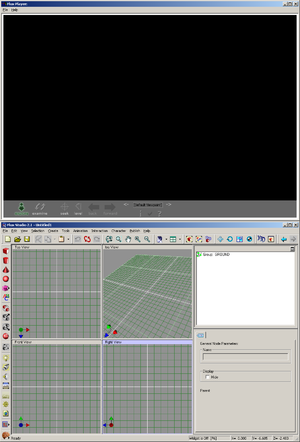Flux single-user client: Difference between revisions
(always x3dv) |
m (moved Flux (software) to Flux single-user client: antonym of existing Flux multi-user server) |
(No difference)
| |
Revision as of 16:32, 22 July 2011
Flux is a 3D software suite released by Media Machines which contains both Flux Player and Flux Studio.
Flux Player is a X3DV viewer that is designed to work both as plugin in a HTML/XML viewer named Internet Explorer, and as standalone program, both inside activation-free Microsoft Windows Me. Flux Studio is a X3DV editor that is designed to work inside activation-free Microsoft Windows Me. Regardless of their design principles, both 3D programs supports Windows Me and higher.
Flux Player and Flux Studio are freely downloadable for any usage under a proprietary Flux Player and Flux Studio license.
Flux software is created and developed by Tony Parisi, who coworked with Mark Pesce on the development of the experimental Open Inventor based VRML prototype called Labyrinth. Tony Parisi went on to develop and retail Intervista/PLATINUM WorldView, a professional-class VRML viewer, which introduced L-shaped navigation bar. Due to common authorship of both standard and software, Tony Parisi's X3DV line of software can be treated as default X3DV software for Web3D in Windows Me, as analogously Internet Explorer is default HTML/XML software for Web2D in Windows Me. Flux Studio can successfully import, manipulate and export *.WRL, *.X3DV and *.X3D files.
Initial joint distribution version of Flux Player 2.0 and Flux Studio 2.0 was released on February 21, 2007; while final joint distribution version of Flux Player 2.1 and Flux Studio 2.1 was released on May 28, 2007.[1]
Flux itself is derived from Pivoron released on December 31, 2001; which features both Cosmo Software compatibility and fullscreen mode.[2]
Fork
In May 2008, Media Machines software was forked as Vivaty software[3][4][5][6]. The Flux Player and Flux Studio software were forked as Vivaty Player and Vivaty Studio.[7] However, in April 2010, Vivaty shut down[8][9], only to be subsequently acquired by Microsoft[10] and Vivaty Player along with Vivaty Studio are no longer available. Both Vivaty Player and Vivaty Studio are designed to work only in activation-featured Windows XP/Vista and higher[11], additionally, Vivaty never went beyond beta stage before its acquisition by Microsoft.
References
External links
- Media Machines download - Redistributables
- Media Machines changelog - Releases
- Graphics Pioneer Tony Parisi appointed Grid Institute fellowship to advance Media Grid standards - Origins
- Software: Web3D - Capabilities
- NEW! Flux Studio 2.0 - Availability
- Media Machines Open Sources FluxPlayer for X3D - Importance
- VRML Browsers - Predecessors



